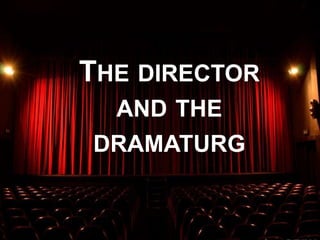The director and the dramaturg
- 2. DRAMATURG ’éó From the German word ŌĆ£ Dramatic AdviserŌĆØ literary manager in Europe. ’éó Helpful to the directors ’āĀ discovering and reading new plays, preparing reports on the history of plays, researching criticism, interpretations, and writing articles for the programs that are distributed when plays are produced. ’āĀ help the directors to decide.
- 4. AUTEUR ’éóIt is a French word meaning ŌĆ£ authorŌĆØ just after WW1
- 5. THE DIRECTOR AND THE PRODUCTION
- 6. THE PHYSICAL PRODUCTION ’éó The directors works with the designer. PROBLEMS IN THE PHYSICAL ELEMENTS ’āśAppropriate props may not be available ’āśThe costume may not fit the performer ’āśScene changes too slow
- 7. CASTING ’éó Directors works with the performers. ’éó In theater it means fitting performers into roles ’éó Derived from the phrase ŌĆ£casting a moldŌĆØ ’āś TYPE CASTING ’āĀ when the performer resembles in real life ’āś CASTING AGAINST TYPE’āĀ putting someone in a role who does not appear to be right for the part.
- 8. REHEARSALS ’éóPracticing ’éóDirector starts to listen or watch the performers in their lines.
- 9. ’éóBLOCKING ’āĀ deciding where the performers move and positions themeselve on the stage.
- 10. THE DIRECTOR AS AN AUDIENCE EYE
- 11. THE DIRECTOR UNDERSCORES THE MEANING OF SPECIFIC SCENES THROUGH THE PHYSICAL ’éó VISUAL COMPOSITION ’éó STAGE PICTURES
- 12. MOVEMENT, PACE AND RHYTHM ’éó THE DIRECTOR MUST OBSERVE THE PERFORMERS MOVEMENT, PACE OF THE STORY, AND RHYTHM IF IT WAS TOO SLOW OR TOO FAST.
- 13. TECHNICAL REHEARSAL ’éó RUN THROUGH SHOW OR PRACTICE FROM THE BEGINNING TO END ’éó DEALS WITH ALL WITH MECHANICAL AND PHYSICAL ASPECTS OF A PRODUCTION
- 14. DRESS REHEARSAL ’éó TO PUT ALL THE ELEMENTS TOGETHER ’éó AS IF THE AUDIENCE WERE PRESENT ’éó WITH NO STOPS AND INTERRUPTIONS ’éó WITH FULL LIGHTS ’éó ALLOWS ANY LAST MINUTE CHANGES
- 15. PREVIEWS ’éó ALSO CALLED AS TRY-OUTS ’éó THE DIRECTOR DISCOVERS WHICH PART OF THE PLAY IS SUCCESSFUL AND WHICH ARE NOT
- 16. THE DIRECTORS POWER AND RESPONSIBILITY ’éó HAS A VOICE IN SO MANY AREAS IF PRODUCTION
- 17. THE PRODUCER OR MANAGER BEHIND THE SCENE, COUNTERPART OF A DIRECTOR
- 18. THE COMMERCIAL PRODUCER ’éó Oversees the entire business and publicity side of the productio nand has the following duties
- 19. ’éó Raising money to finance the production ’éó Securing rights to the script ’éó Dealing with the agents for the playwright ,director and performers ’éó Hiring the director, performers. Designers and stage crews ’éó Dealing with theatrical unions ’éó Renting the theater space ’éó Supervising the work of those running the theater in the box office, auditorium, and business office ’éó Supervising and advertising ’éó Overseeing budget and a week-to-week financial management of the production
- 20. NON COMMERCIAL THEATERS ’éó The producer is called ŌĆ£ executive director ŌĆ£ or ŌĆ£ managing directorŌĆØ
- 21. ADMINISTRATIVE ORGANIZATION OF A NON PROFIT THEATER ’éó Non commercial theaters are organize by board of directors, an artistic director and executive or managing director.
- 22. RESPONSIBILITIES OF A NONCOMMERCIAL PRODUCER OR MANAGER ’éó Responsible for the maintenance of theater building, ’éó Responsible for the budget ’éó Responsible for publicity ’éó Etc.
- 23. COMPLETING THE PICTURE: PLAYWRIGHT, DIRECTOR, AND THE PRODUCER
- 24. PLAYWRIGHT ’āĀPuts the words and ideas together PERFORMERS ’āĀBrings the ideas into life
- 25. ’éóDIRECTOR ’āĀIntegrates the artistic element ’éóPRODUCER ’āĀcoordinates the business side of the production
- 26. THANK YOU FOR LISTENING Created by : Gerard F. Tolero

























